Modestine stands alone in the middle of an open field equidistant between the shower block and the village football pitch. The rain is streaming down and England is beginning to seem a very attractive prospect! We have discovered that there is not a great deal to do in Denmark on a wet weekend even in August.
This morning started pleasantly enough. Over breakfast Ian discovered from his map that there was a church near Skagen set amongst the dunes, that had been completely covered by sand during the 18th century. All that remains visible is the tower which has been maintained as a navigation aid. It proved a pleasant activity seeking it out on foot beyond a pine forest, lying amongst the sand and heather. From the top of the tower, reached by a couple of flights of narrow, rickety wooden steps, we had a view over the tree tops to the coast and the harbour at Skagen.
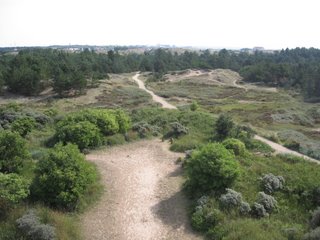 Path through the dunes to the buried church, Skagen
Path through the dunes to the buried church, Skagen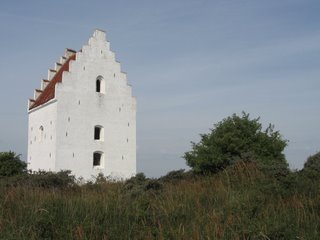 Tower of the buried church, Skagen
Tower of the buried church, SkagenCloser investigaton of his map had convinced Ian that he could now find the elusive moving sand dune of Råbjerg Mile. By now the weather had clouded over and there seemed little else of comparable excitement so we set off to find it. When we did the parking area was crowded with Italian camper vans! Can you credit it! The wonders of Venice and the splendours of Ravenna have been forsaken and Italians have been streaming north to the tip of Jutland to see Denmark's moving sand dune! Shedding sandals as we went we ploughed our way across a huge incline of soft, silver sand that wisped along in clouds around our ankles, carried by the constant wind that blew across the summit. From the top we had an all round vista of the wide, white dune, the sea and the surrounding heath land and marram grass. A few hardy souls were flying kites but otherwise it was a deserted wasteland. After all our travels to the wonderful sights of Europe we are reduced to standing watching the sand move! There wasn't even a camel to relieve the monotony of the landscape! Jill thought it the most boring view anywhere whereas Ian said he thought it quite fascinating and was greatly impressed by it. There are a great many Italians and Danes who would support Ian's view rather than Jill's. Make your own decision. Is this the world's most boring photo or is it not?
 Sand dune at Råbjerg Mile
Sand dune at Råbjerg Mile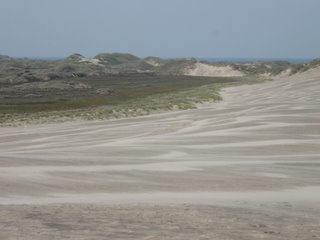 Sand dune on the move, Råbjerg Mile
Sand dune on the move, Råbjerg MileWe continued to Frederikshavn on the shores of the Kattegat from where the ferries leave for Sweden. It has a populaton of 34,000 but today they were not in evidence. It is a more attractive town than Hirtshals on the Skaggerak but on a Saturday afternoon it is not exactly humming with excitement.
 Main shopping area on a Saturday afternoon, Frederikshavn
Main shopping area on a Saturday afternoon, FrederikshavnEven the library was closed as were most of the shops! The foyer of the museum had an exhibition on Ex Libris bookplates from its collections which delighted Ian. Sand dunes and labels in one day! Just how exciting can Denmark get? Stay with us, there is more to come!
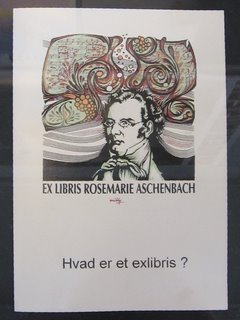 Exlibris collection, Frederikshavn
Exlibris collection, Frederikshavn Musical bookplates from the Exlibris collection, Frederikshavn
Musical bookplates from the Exlibris collection, FrederikshavnThe sky turned leaden as we walked the silent streets of the town centre and we rushed for the liveliest place in town – the ferry terminal! Here we sheltered with cups of coffee in the departure lounge until the rain eased. The tourist office suggested our best bet for internet access was the terminal hotel. Here we were quoted £8 an hour for access. An improvement on yesterday in Skagen where it was £12! (Except that we have discovered it is free in the library!) We declined the hotel's offer and eventually discovered an internet shop in a side street where we had an hour's use for £2.50. That was just about as exciting as a Saturday afternoon gets in Frederikshavn!
It does though have some of the most exciting manhole and troll hole covers we have yet seen in Denmark. Here, being a port, there is a serious immigration problem with Latvian trolls trying to smuggle their way into the Scandinavian countries via Sweden. The waters of the Kattegat and the port of Frederikshavn prove an easy access point for troll smuggling. No sooner do they land than they are hidden safely beneath the pavements of the town from where a network of tunnels takes then right across Denmark, passing beneath the Limfjorden to come up on the streets of Randers. From here of course it is perfectly easy for these illegal trolls to infiltrate the rest of Denmark. Even without identity papers many find easy troll work on the sand-moving night shift at Råbjerg Mile to ensure it keeps moving at the rate of 15 metres a year!
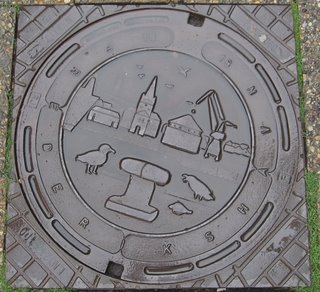 Manhole cover, Frederikshavn
Manhole cover, Frederikshavn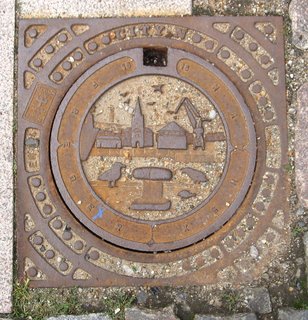 Much small troll hole cover, Frederikshavn
Much small troll hole cover, FrederikshavnFrederikshavn does not have a campsite within the town. Nobody seems to want to stay there. We are on one of the only two in the area, it is at least 10 miles away and we have the site to ourselves. On our way here we called off around 5.30pm to look at the port at Strandby. It looks a pleasant little working port full of fishing vessels and a few small quayside fish freezing companies.
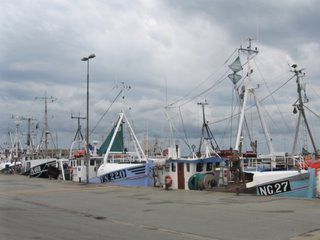 Fishing boats in the harbour at Strandby
Fishing boats in the harbour at StrandbyThis weekend however the flags were out - hundreds of them. They all looked exactly the same. It has begun to dawn on us that the Danish flag must be red with a white cross. A flag of that description flies from every building of any importance in every town throughout the country. In Strandby today there was a harbourside funtime for all the local residents with exciting activities like tombola and a second hand market selling battered Moomin figures, chipped ashtrays saying "a present from Copenhagen" in Danish and lots of back issues of National Geographic. They were also selling drinks, ice creams, chips and hot dogs and to one side people were laying out the festive supper of curried rollmops, fried fish, fish cakes, rye bread and potato salad. Excitement was rising and activities looked set to continue well into the evening, possibly even until 8pm.
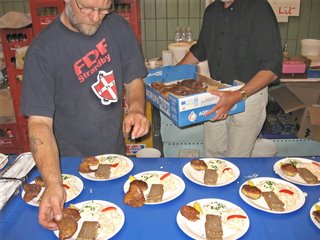 Loaves and fishes, Strandby
Loaves and fishes, StrandbyAttracted by the sound of rhythmic clapping and cheering we made our way to one of the large boat hangers. Here the entire village was crowded round while young boys and girls of around 11 or 12 years old danced quite unselfconsciously, smartly dressed in dark suits or long dresses with shawls. It was the final of the ballroom dancing championship and everyone was there to support them! The Danes definitely have their own concept of fun at a summer fete. Everyone was enjoying it greatly as they crowded round. We were reduced to finding a couple of chairs to stand on to see what it was all about. The Danes are quite tall as a nation and we felt quite dwarfed at the back of the crowd!
 Come dancing, Strandby
Come dancing, Strandby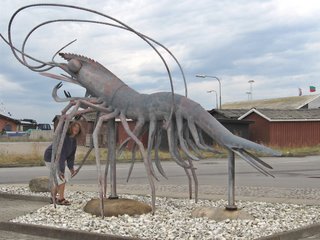 Jill is invited to dance the lobster quadrille, Strandby
Jill is invited to dance the lobster quadrille, StrandbyAll this is not meant to sound unkind. We have not really spoken to enough Danish people to get under the skin of the country so can only make generalisations. As a nation they seem to have a lot in common with the British. Probably a Dane in Devon on a wet Saturday would find us an odd lot and marvel at our drum majorettes and scones and jam in a soggy tent. Certainly we found our interlude in Strandby entertaining. We would like to think though that there is something just a tad more exciting for people here sometimes.
Sunday 13th August 2006, Sæby, Jutland Peninsula, Denmark
How about synchronised chair folding? More about that later.
After a night of rain we woke to a grey and cloudy day. The campsite, which seemed so desolate when we arrived, turned out to be one of the nicest and cheapest we have used anywhere. After hot free showers we carried our breakfast things to a communal room, shared by the family and several cyclist who had slept in bunk bed dormitories inside the main building. Here Ian was able to watch Sunday morning cartoons on Danish TV with the kids while we ate our own food at pine tables with candles burning and a jug of coffee provided without charge as is so often the custom here. Above each table hung a low red enamelled lamp exactly like the one we used to have back in the 1970s that seemed so smart at the time and ended up in a jumble sale somewhere. Here that era of Danish design is still going strong. Incidentally, the Danes love candles. They are always lit on restaurant tables regardless of the time of day, even if you only want a coffee. Today we even discovered a couple in smart hanging containers alight in a public toilet! Which leads neatly on to the next comment. Denmark takes a real pride in its public facilities. Never have we seen a country with so many toilets and every one gleaming clean, nicely appointed with paper, soap and disposable hand towels. Driving through the countryside there are even lay-bys and picnic areas at frequent intervals with public facilities clearly advertised from the road. All are immaculate and clean. It makes it all the more strange that there is so much dog fouling here. It is nothing like as bad as southern France but far worse than other countries in Northern Europe.
Today we visited Bangsbo, to the south of Frederikshavn. It is a museum housed in a former manor house of the 17th century with a deer park and botanical gardens in the grounds. It was raining as we arrived and Modestine stood alone in the car park. Where is everyone in Denmark? This is an August Sunday and this is one of the main places of cultural interest in the area!
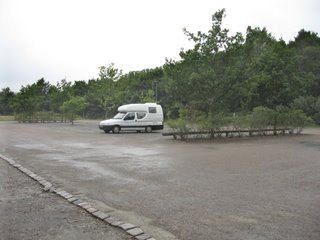 All alone at Bangsbo
All alone at BangsboThe building was beautiful. Set in a large moat where ducks swim and willows bend to regard their reflections in the water, it has a timber frame and a thatched roof. Forming one wing of the building and housing the museum of carriages is the oldest barn in Denmark built in the 1580s.
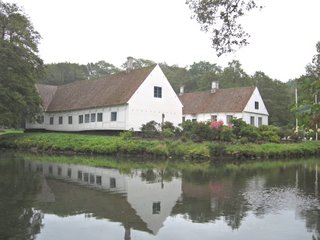 Old farmhouse at Bangsbo, now a museum
Old farmhouse at Bangsbo, now a museum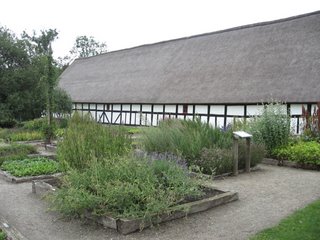 Old barn at Bangsbo
Old barn at Bangsbo 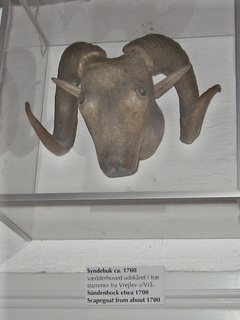 Scapegoat, Bangsbo museum
Scapegoat, Bangsbo museumScapegoats were hung in houses to take on the troubles of an unquiet ghost
We spent several hours at the house as it contained a number of things we wished to discover, including a collection of documents, archives and memorabilia about Denmark's position during the Second World War. We knew very little about this and from what we have learnt it seems to have been a very uncomfortable episode for the Danish people. The country was invaded and occupied by Germany from 1940 to 1945. The army met with no resistance, the Danish government immediately surrendering to Germany. Initially Denmark co-operated and with the acquiescence of its government many young men joined the German forces fighting on the eastern front. Gradually however, encouraged and supported by Britain, a resistance movement developed which by 1943 began to achieve considerable success against the occupying German forces, particularly in the area of transport sabotage.
For the ordinary Danish people it was difficult to know what to think. There was little that they could do against the occupying power. Their government ordered them to obey the German occupiers who generally left them alone with little in the way of persecution as there was in other parts of Europe. It was not until 1943 that Germany turned its attention to Danish Jews and by then the Resistance movement had developed to such a degree that most Jews were able to be evacuated across to Sweden. After the war there were many recriminations amongst the Danes against those who had collaborated openly with the Germans. There were many business men and farmers who had actually done very well from the German occupation and become rich. In fact all this was rapidly lost later when German money was devalued and their savings became worthless.
Passive resistance was all many dared to show. One touch that amused us was a fashion for wearing crocheted berets in red, white and blue looking exactly like the markings on the RAF fighter planes that were carrying out regular raids in Denmark from bases in Norfolk and East Anglia.
Later in the afternoon we explored a network of German wartime bunkers on the cliff-tops above the town of Frederikshavn where a whole series of guns were trained on the waters of the Kattegat. These formed part of the "Atlantic Wall" constructed by the Germans against possible Allied attacks by sea. Over the years we have seen these bunkers as far south as Cap Ferret in Southern France, in the Channel Islands, along the coast of Brittany and Normandy and now right up into Denmark. There will presumably also be similar defences along the coast of Norway as it too was occupied. Most bunkers we have visited in Normandy have seen very active service and are battered and broken, their guns long since removed or rusted away. Here the bunkers were never attacked and they stand today much as they were when occupied by the German military. Their guns are still trained on the sea beyond Frederikshavn but today picnic tables are placed immediately beyond the muzzles and sheep graze the grass on the roofs of the bunkers. Inside they contain the original fitments with bunk beds for off duty use, cupboards for personal possessions, radio control rooms, radar equipment – we had not realised Germans used radar, and command rooms with long tables for debriefing sessions. The rooms are constructed from 2 metre thick reinforced concrete with huge iron doors, ventilation shafts and gun turrets. They were definitely designed for functionality and strength and are as hideously ugly today as they ever were despite the best efforts of nature to mask them externally with brambles and wild plants.
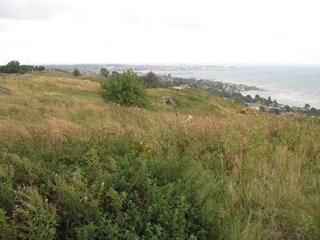 Frederikshavn seen from the bunkers
Frederikshavn seen from the bunkers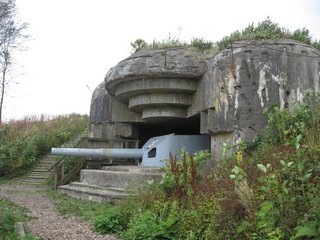 One of the bunkers on the cliffs overlooking Frederikshavn
One of the bunkers on the cliffs overlooking Frederikshavn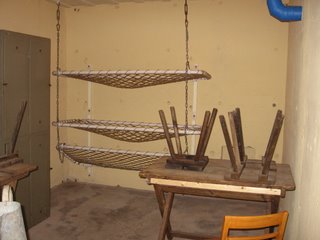 Inside one of the bunkers on the cliffs overlooking Frederikshavn
Inside one of the bunkers on the cliffs overlooking FrederikshavnBangsbo museum had a very mixed collection of exhibits ranging from the largest collection of objects made from human hair in Europe to the remains of a Viking ship dating from 1163. More than half of the original timber of this remain and have been positioned in their original location within an iron supporting frame to show the shape of the whole ship. It was discovered in a nearby river estuary in the 1950s and is very similar to those depicted in the Bayeux tapestry.
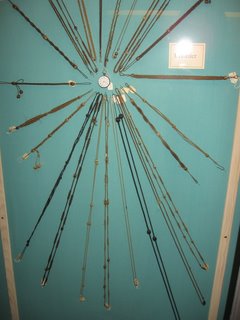 Watch chains made from human hair, Bangsbo museum
Watch chains made from human hair, Bangsbo museum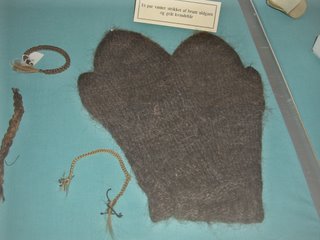 Mittens knitted from human hair, Bangsbo museum
Mittens knitted from human hair, Bangsbo museum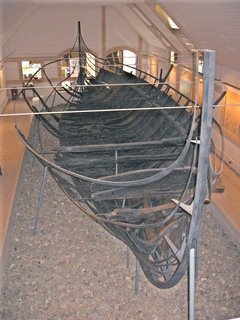 Remains of a Viking ship, Bangsbo museum
Remains of a Viking ship, Bangsbo museumSo one way and another the day passed and we hadn't yet visited Sæby, which we expected to have done by lunch time before continuing on to Aalborg during the afternoon. We abandoned that plan and simply made our way to Sæby, on the coast a short way south of Frederikshavn.
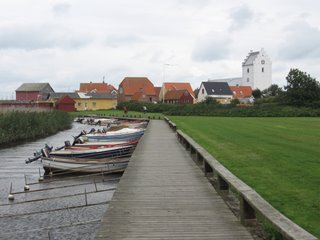 Sæby
SæbyIt has proved to be as pleasant as we anticipated. In the 19th century it attracted writers much as Skagen attracted painters. We discovered a rather incomprehensible exhibition on the Norwegian writer Henrik Ibsen who wrote "Woman from the Sea" here around 1887. He was attracted to Sæby – if we have unravelled the Danish text correctly – following the suicide at the age of 21 of a female writer from the town. Her life and the events of her death in 1883 formed the basis for this work. On the harbour stands a large statue representing his "Woman from the Sea" and in a very pretty little street in the town we discovered the home of the tragic young writer looking very peaceful with its yellow rendered walls and hollyhocks around the door.
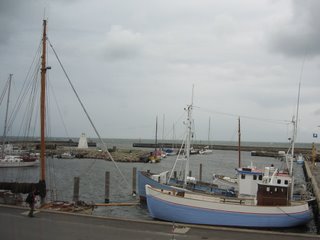 Harbour, Sæby
Harbour, Sæby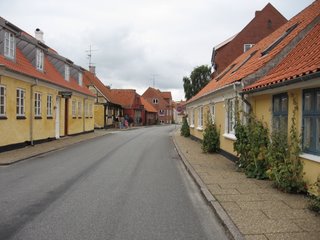 On the street where she lived, Sæby
On the street where she lived, SæbyThe sound of a brass band playing attracted us to the very pretty public gardens where a marquee had been set up, there were tables and benches set out and people were walking around in top hats and tails or long voile dresses and big flower-trimmed hats. At first we thought we had gate-crashed a wedding party but it was only Danes enjoying themselves in a rather charming and old fashioned way on a Sunday afternoon. Once the brass band stopped a group of fiddlers took over and people in their decorous fancy dress danced in genteel fashion on the lawn. Meanwhile salads were being served with glasses of wine and groups were sitting at tables listening to the music. We bought a couple of coffees and sat by the entrance to the marquee to watch and listen. It was all delightfully pleasant. Even many of the young children were dressed in 19th century clothes while artists wearing straw boaters were painting at easels beside the rose bushes.
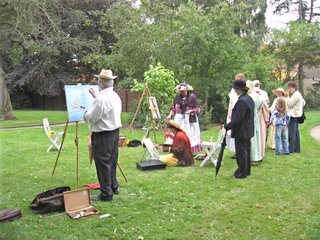 Artists at work, Sæby
Artists at work, Sæby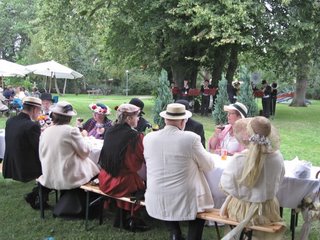 Enjoying refreshments, Sæby
Enjoying refreshments, Sæby Danish disco, Sæby
Danish disco, SæbyAt this point it started to drizzle. People who had been sitting on their folding chairs listening to the music from the lawn rose as one and immediately began folding their chairs and popping them back into their long carrying bags. The women won this event easily, having the strings tied neatly on the bags while the men were still trying to work out which chair leg folded first and how does it fit into the bag with the arm rest sticking out like that. One family of four, all with red and white chairs to match the Danish flag, were so skilled it was fascinating just to watch and they all managed to finish together, quite oblivious to our admiring stares.
The rain decided us to move on. We found a campsite nearby where we have been given a pitch overlooking the sea. The wind is howling outside and the waves rushing in, capped with white horses. We are thankfully snug in Modestine and the rain is only squally and spasmodic. We hope it improved before Tuesday though as we have to cross to Norway and the North Sea may well be more windy than we are used to in the English Channel.
Monday 14th August 2006, Hirtshals, Jutland Peninsula, Denmark
We are at the campsite on the clifftops near the port waiting to catch the ferry to Kristiansand tomorrow lunchtime. There are more camping cars gathered here than we have seen throughout Jutland over recent days and they are presumably doing the same as us. Most are German or Italian. There are no other British vehicles here. We have only seen one other British car since we have been in Northern Demark. A German couple have just come to question us about Modestine. They have recently retired and are fascinated with the idea that we have spent a year travelling Europe in Modestine. They have suggested we sell her to them once we have returned home in a couple of weeks time! Ian has loyally assured them we would not sell her for her weight in gold!
As we write we are overlooking the North Sea and the waters of the Skaggerak. The air is calm and the evening light reflecting softly from the water. It is as peaceful here as it was rough last night. If it stays like this we should have a very pleasant crossing tomorrow.
We checked our email at the library this morning when we were visiting Hjørring, on the off chance of a reply to our email to Jill's cousin trying to make contact with the people we know here in Hirtshals. Alas, they are still on holiday and our chance has gone. This evening we walked the cliffs here and found ourselves looking closely at everyone we passed in case they happened to be Tina's family!
This morning we completely abandoned our tentative plan to visit Aalborg when we realised it would be a rushed affair if we were to be at Hirtshals this evening. Instead we contented ourselves with exploring the town of Hjørring just a short distance south east of Hirtshals.
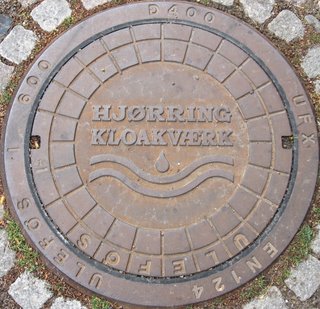 Welcome to Hjørring
Welcome to HjørringIt proved to be a pleasant place with modern shops, nice houses, several parks, churches and museums but no real "pazzaz". Actually that is a reasonable summary of the whole of Denmark! We regret having to say so but it is the least stimulating country we have yet visited during our travels though it has one of the best standards of living. Everyone here appears to have a reasonable income and the education system seems good – certainly everyone we have spoken to speaks really excellent English and almost certainly German as well. There are no beggars, unemployment does not seem an issue, there are no disaffected young people on the streets and the walls are generally free from graffiti. Everywhere feels safe and secure, you are told when and where you are allowed to cross the road. There are very few bars around so people don't sit drinking during the day and it seems unlikely that there is a serious drugs problem here, despite having special containers in the toilets for the reception of needles and sharps. Denmark is a monarchy and there seems to be a very great affection for their royal family. Along with the Danish flag, their faces are seen everywhere. We have not seen a single EU flag while we have been here whereas in the rest of Europe they are generally more common than national flags –except during the World Cup.
As every follower of the Hitchhiker's Guide to the Galaxy will be aware, the fjords and coastline of Norway were designed by Slartibartfast. Presuming his cartographic labours to have finally been concluded Ian searched the bookshops of Hjørring for a map of Southern Norway. We now hope we will be able to find our way along the coast from Kristiansand to Stavanger without ending up at the wrong end of too many fjords. Norwegian is apparently very similar to Danish so we hope to muddle by with the phrasebook we already have. If they speak English there half as well as they do in Denmark we won't really need to use it anyway.
There are very few restaurants to be found in the towns of Northern Denmark and where they exist they are expensive and the menus rather boring, generally consisting of an open sandwich with salad, chicken or prawns and potato salad. So we bought overfilled rolls – also rather boring - containing Danish meatballs, salad, peas and grated carrot. These we ate in the park – what didn't fall out the ends of the rolls over the flowerbeds of marigolds and candytuft.
Having already seen most of the 160 statues and fountains of Hjørring, many of them very expressive, most of them granite, we decided to visit the museum. Usually we would not choose two local history museums on consecutive days but entertainment is limited when you are obliged to hang around a particular area waiting for a ferry crossing. It was an excellent museum but too similar to that of Bangsbo yesterday for us to become fully absorbed. It did though have the skeleton of the last person to be executed in the town back in 1822. He had poisoned his wife and ended up being beheaded and his skull publicly displayed on an iron spike. This is still sticking through his skull today!
There was also a special exhibition concerning a spinning top invented in the town in the 1950s which is still puzzling scientists today. Known as a tippi-toppi it has a habit of turning itself upside down as it spins. How's that for excitement? The real highlight of our visit though was the special exhibition of knitting! It is almost exclusively the work of one lady who had produced an unbelievably huge number of knitted cardies, gloves, scarves, hats, socks, bathing costumes, long johns, blanket squares and baby clothes in her lifetime. Many were rather worn, most were old fashioned, all were ugly and shapeless. Many were knitted with Fair Isle and Norwegian patterns and together they filled several rooms of the pretty former vicarage of Sindal which now stands in the grounds of the museum.
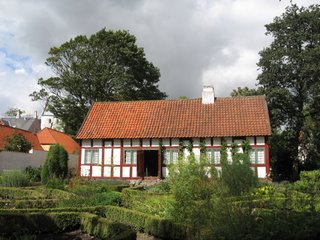 Sindal vicarage, Hjørring
Sindal vicarage, HjørringAt last we have found someone capable of out-knitting Ian's mum, a woolly blanket squares knitter of outstanding productivity! She would have been so impressed at the exhibition we saw today, so we would like the displays of assorted socks and squares illustrated here to stand as an affectionate tribute from us to her memory.
 Knitted socks, Hjørring
Knitted socks, Hjørring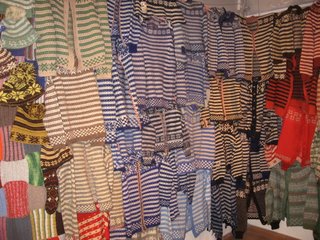 Knitted cardigans, Hjørring
Knitted cardigans, Hjørring Assorted knit-nacks, Hjørring
Assorted knit-nacks, HjørringReturning to Modestine we passed a shop specialising in Scandinavian design. Like the rest of Denmark they seemed to hark back to the 1960s. Indeed, everything about Denmark gives the impression that it has never left this era. Having discovered a new, contemporary design that led the world, why change? Denmark lingered in its old Habitats while the rest of the world moved on so far it has now come full-circle with designs from Ikea!
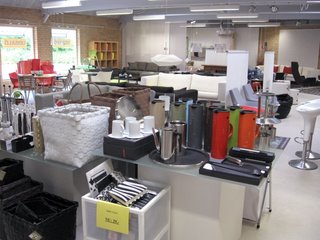 Scandinavian design "butik", Hjørring
Scandinavian design "butik", HjørringAfter yet another day on our feet walking cobbled streets, Jill's ankle problem had returned so we left Hjørring, feeling we had seen most of what it had to offer, limped back to Modestine and made our way up here to Hirtshals.
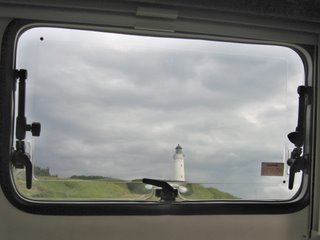 Hirtshals' lighthouse seen from Modestine's window as we write
Hirtshals' lighthouse seen from Modestine's window as we writeTuesday 15th August 2006, Kristiansand, Norway
Hirtshals did not improve greatly on further acquaintance this morning. At least it wasn't raining but by the time we left the campsite there were only a couple of hours before we needed to report for check-in at the ferry terminal, so it was not worth visiting the North Sea Museum which apparently has a huge aquarium filled with cod and flounders. If it is like the one at Plymouth it would certainly merit more time than we had available so we decided to explore the town in more detail than we did last week in the rain. It is apparently a modern town having been established only in the 1920s, following the construction of the port which really remains as its be-all and end-all. There was little more to see and we contented ourselves with a stroll along the sandy beach, backed by sand dunes. Here at last Ian's fantasies were realised when a naked lady rushed out from the dunes to bounce happily in the shallow waves! Certainly that was the most Hirtshals was able to offer in the way of entertainment. We found ourselves reduced to wandering around the supermarkets to kill time until we could reasonably check in at the port.
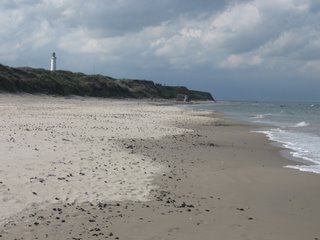 Hirtshals' lighthouse, sand dunes and the beach
Hirtshals' lighthouse, sand dunes and the beach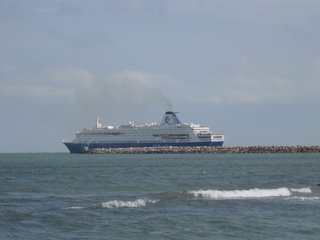 Ferry to Norway leaving Hirtshals, seen from the beach
Ferry to Norway leaving Hirtshals, seen from the beachSo we have left Denmark without any great regret. In general, friendly as the Danes undoubtedly are, it not a particularly interesting country. Randers and Odense stand out as more stimulating than Jutland, and the Limfjorden was peaceful and beautiful. There have been some very pleasant moments but we have sometimes had to search for interesting incidents for the blog, whereas in most other countries we have visited this year we have been overwhelmed by them.
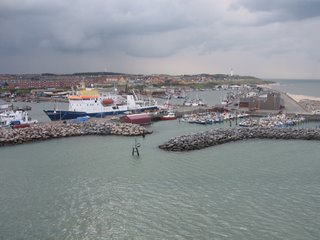 Farewell to Hirtshals and Denmark
Farewell to Hirtshals and DenmarkThe ferry is run by the Norwegian company Color Line. The one we travelled on today, King Christian IV, was not as luxuriously appointed as most of the Brittany Ferries ships we have used but it was considerably cheaper and quite adequate. The crossing took nearly five hours and was really smooth. We were informed that we could acquire some Norwegian currency at 3pm when the satellite would be overhead and our visa card would work on board! We are innocents where such matters are concerned and it seemed rather exciting to link to our Nationwide account while out on the North Sea approaching Norway! At least we didn't have to search for somewhere to park and a cash machine as soon as we had landed. We arrived around 6.15pm after passing between a series of small islands, the granite mainland looking far more hilly than the flat sandy coast of Denmark we had recently left. It is quite apparent now where all the granite boulders lying on the sandy beaches or set up in people's gardens, in parks and outside public buildings in Denmark come from. Our approach to Kristiansand harbour reminded us rather of entering Plymouth Sound and passing Drake's Island when returning on the Santander ferry. Here though the granite coastline was ridged and scoured during the Ice Age.
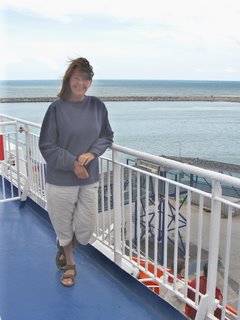 Jill on board the King Christian IV
Jill on board the King Christian IV Hello to Kristiansand and Norway
Hello to Kristiansand and Norway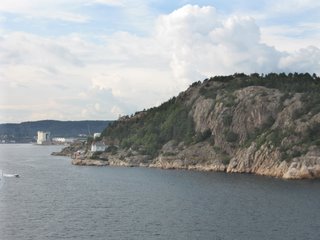 Granite coast approaching Kristiansand
Granite coast approaching KristiansandKristiansand is a town of about 80,000 people. We knew there was a campsite east of the town and made our way directly there passing through a series of long road tunnels to get out of the town. The site seems very nice with lovely views over the sound though it is more expensive even than Denmark, assuming Norwegian Kroners to be of the same value as the Danish ones. We feel comfortable on this site. It could be Devon really with the view of the sea, rocky islets, a jetty with boats moored and here on the site a jumble of large granite boulders, rowan trees with their red berries and wooded paths leading steeply up through pine trees. We will stay a couple of nights here to give us chance to explore the town tomorrow.
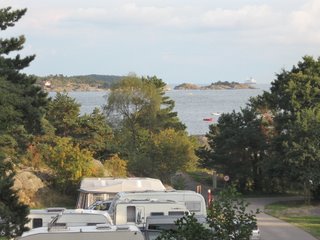 View from Modestine at our campsite near Kristiansand as our ferry returns to Denmark
View from Modestine at our campsite near Kristiansand as our ferry returns to Denmark